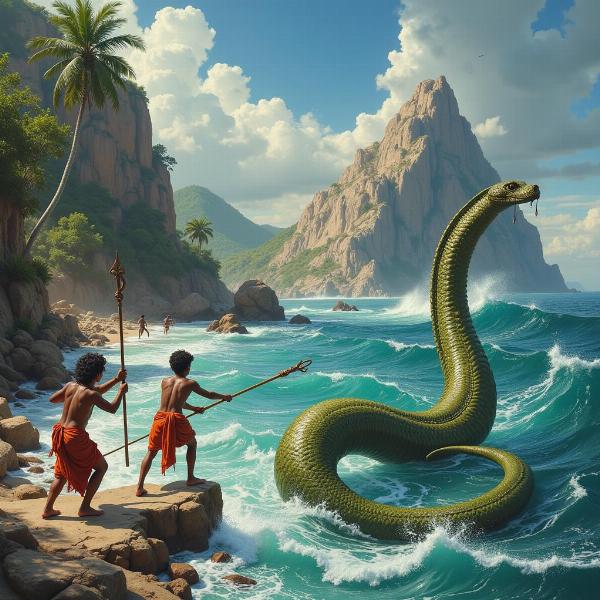The search for “dragon meaning in Hindi” often stems from a curiosity about the mythical creature’s significance in Indian culture and mythology. While dragons aren’t indigenous to India in the same way they are to East Asian cultures, they hold a unique place in Hindu scriptures and folklore, often symbolizing power, chaos, and guardianship. This article delves deep into the various interpretations of the dragon in Hindi, exploring its representations in ancient texts, religious beliefs, and popular culture.
The Many Faces of the Dragon in Hindu Mythology
In Hindu mythology, dragons, or serpent-like creatures often referred to as Nāgas, play multifaceted roles. They can be benevolent protectors of treasure, fierce guardians of sacred spaces, or even destructive forces of nature. Understanding these varying representations is key to grasping the dragon’s symbolic richness.
Nāgas: The Serpent Gods of Hindu Lore
Nāgas are often depicted as powerful serpentine deities, inhabiting both earthly and aquatic realms. They are associated with water, fertility, and guardianship. The most prominent Nāga is Vasuki, who served as the rope during the churning of the ocean, a pivotal event in Hindu cosmology.
 Vasuki Churning the Ocean
Vasuki Churning the Ocean
Vritra: The Dragon of Drought and Chaos
Unlike the generally benevolent Nāgas, Vritra embodies a more malevolent aspect of the dragon. He is a demonic serpent who holds captive the waters of the world, causing drought and chaos. Indra, the king of the gods, eventually slays Vritra, releasing the life-giving waters and restoring balance to the cosmos.
Ahi: The Serpent of Darkness
Similar to Vritra, Ahi is often associated with darkness and malevolence. He represents the forces of chaos that oppose the gods. These serpentine figures highlight the dragon’s dual nature, capable of both destruction and creation.
Dragon Symbolism in Modern India
The image of the dragon continues to resonate in modern India, appearing in various forms of art, literature, and popular culture. While the traditional mythological interpretations remain prevalent, the dragon has also absorbed influences from other cultures, particularly from East Asian depictions.
Dragons in Popular Culture
From Bollywood films to comic books, dragons have become a recurring motif, often representing power, magic, and mystery. This integration reflects the ongoing evolution of the dragon’s symbolism in the Indian consciousness.
Dragons in Art and Architecture
Dragon motifs can be found in traditional Indian art and architecture, particularly in temples and sculptures. These depictions often blend the serpentine features of Nāgas with more conventional dragon imagery, showcasing a cultural fusion.
FAQ: Understanding Dragon Symbolism in Hindi
- What is the Hindi word for dragon? While there isn’t a single, universally accepted Hindi word for “dragon,” terms like ajgar (python) and sap (snake) are often used in context, especially when referring to large, mythical serpents. The term asur, meaning demon, is also sometimes used in association with malevolent dragons like Vritra.
- Are dragons considered good or evil in Hindu mythology? Dragons in Hindu mythology are neither inherently good nor evil. They embody both benevolent and malevolent aspects, depending on their specific representation. Nāgas are often seen as protectors, while figures like Vritra and Ahi represent chaotic forces.
- What is the significance of Vasuki in Hindu mythology? Vasuki, the serpent king, played a crucial role in the churning of the ocean, a pivotal event that led to the creation of amrita, the elixir of immortality.
- How does the Indian dragon differ from the East Asian dragon? While both share reptilian features, Indian dragons are more closely associated with serpents and water deities, while East Asian dragons are often depicted with wings and associated with celestial power.
- What is the cultural significance of dragons in modern India? Dragons continue to hold symbolic value in modern India, appearing in art, literature, and popular culture, often representing power, magic, and mystery.
- Where can I find depictions of dragons in Indian art and architecture? Dragon motifs can be found in various temples and sculptures across India, often blended with traditional Naga imagery.
- How can I learn more about the dragon’s symbolism in Hindi? Exploring ancient Hindu texts, folklore, and scholarly works on Indian mythology can provide deeper insights into the dragon’s diverse representations.
Conclusion: The Enduring Legacy of the Dragon
The dragon, in its various forms and interpretations, continues to captivate the imagination in India. From the benevolent Nāgas to the destructive Vritra, the “dragon meaning in Hindi” encompasses a rich tapestry of symbolism, reflecting the complex relationship between humans and the natural world, the forces of creation and destruction, and the eternal struggle between order and chaos.
Meaning-Hindi.in is your premier destination for professional Hindi translation services. We specialize in translating business documents, legal contracts, technical manuals, website content, educational materials, and more. Our expert linguists possess a deep understanding of Indian culture and language nuances, ensuring accurate and culturally sensitive translations. Whether you need quick turnaround times or specialized industry expertise, Meaning-Hindi.in is committed to delivering high-quality translations tailored to your specific needs. Contact us today for a free quote at [email protected] or call us at +91 11-4502-7584.